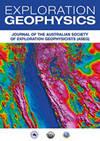Seismic structure-constrained inversion of CSAMT data for detecting karst caves
IF 0.8
4区 地球科学
Q4 GEOCHEMISTRY & GEOPHYSICS
引用次数: 2
Abstract
Karst cave is a sort of special and buried geological structure that was widely developed in the Permo-Carboniferous coal accumulation area of North China. It brings karst collapse and safety hazard in the mining industry. In this study, we propose a seismic structure-constrained inversion of controlled source audio-frequency magnetotelluric (CSAMT) data on a detailed survey and detection of karst caves. Instead of constrained by seismic impedance, the method in this study directly takes the seismic imaging results as structural constraints, which is different from the cross-gradient technique used by conventional structural constraints. First, the seismic migration section is divided according to the CSAMT inversion grid and applied pixel extraction for each grid. Clustering is carried out according to the structural information interpreted by the seismic migration section and the average pixel value of each cluster is calculated. Then the clustered results were used in the seismic structure-constrained inversion of CSAMT data based on cross-gradient technique. After that, as a karst cave model developed in limestone was established, the study compares the structure-constrained inversions with different clustering strategies shows a much more precision of karst cave detection than the method only applies CSAMT data. Moreover, experimental verification is provided in this study, which is for the detection of a suspected karst collapse column from Shandong Province, China. The comparison results further show that the structure-constrained inversion method proposed in this paper is applicable and may effectively improve the locating accuracy of karst caves.CSAMT探测溶洞的地震结构约束反演
溶洞是华北二叠石炭系煤田聚集区广泛发育的一种特殊的隐伏地质构造。它给采矿业带来了岩溶塌陷和安全隐患。本文提出了一种控制源音频大地电磁(CSAMT)数据的地震结构约束反演方法,用于岩溶洞穴的详细调查和探测。该方法不受地震阻抗约束,直接将地震成像结果作为结构约束,不同于传统结构约束的交叉梯度技术。首先,根据CSAMT反演网格划分地震偏移剖面,并对每个网格进行像元提取;根据地震偏移剖面解译的构造信息进行聚类,并计算各聚类的平均像元值。然后将聚类结果应用于基于交叉梯度技术的CSAMT地震结构约束反演。之后,在石灰岩中建立了溶洞模型,对比了不同聚类策略下结构约束反演的溶洞检测精度,表明该方法比仅应用CSAMT数据的方法要高得多。并对山东某地疑似岩溶陷落柱的检测进行了实验验证。对比结果进一步表明,本文提出的结构约束反演方法是适用的,可以有效提高溶洞的定位精度。
本文章由计算机程序翻译,如有差异,请以英文原文为准。
求助全文
约1分钟内获得全文
求助全文
来源期刊

Exploration Geophysics
地学-地球化学与地球物理
CiteScore
2.30
自引率
0.00%
发文量
33
审稿时长
>12 weeks
期刊介绍:
Exploration Geophysics is published on behalf of the Australian Society of Exploration Geophysicists (ASEG), Society of Exploration Geophysics of Japan (SEGJ), and Korean Society of Earth and Exploration Geophysicists (KSEG).
The journal presents significant case histories, advances in data interpretation, and theoretical developments resulting from original research in exploration and applied geophysics. Papers that may have implications for field practice in Australia, even if they report work from other continents, will be welcome. ´Exploration and applied geophysics´ will be interpreted broadly by the editors, so that geotechnical and environmental studies are by no means precluded.
Papers are expected to be of a high standard. Exploration Geophysics uses an international pool of reviewers drawn from industry and academic authorities as selected by the editorial panel.
The journal provides a common meeting ground for geophysicists active in either field studies or basic research.
 求助内容:
求助内容: 应助结果提醒方式:
应助结果提醒方式:


